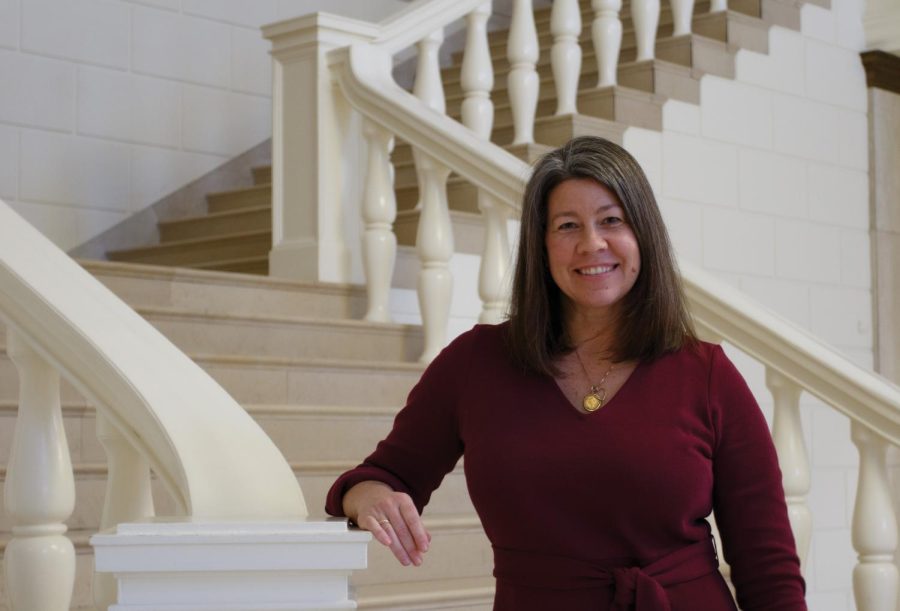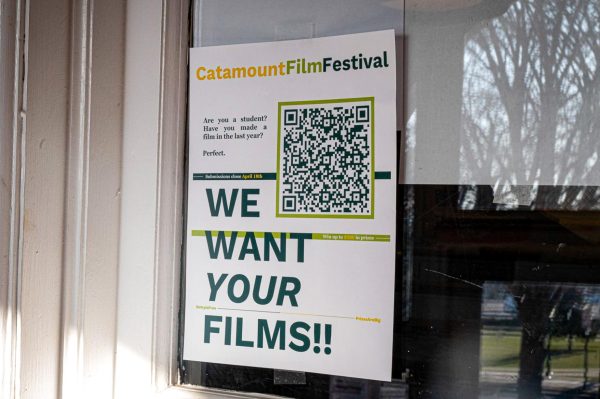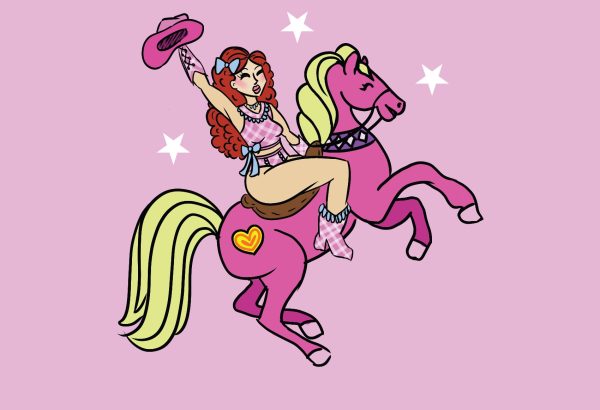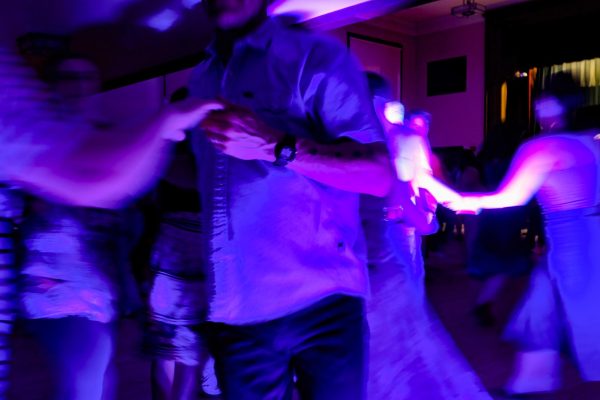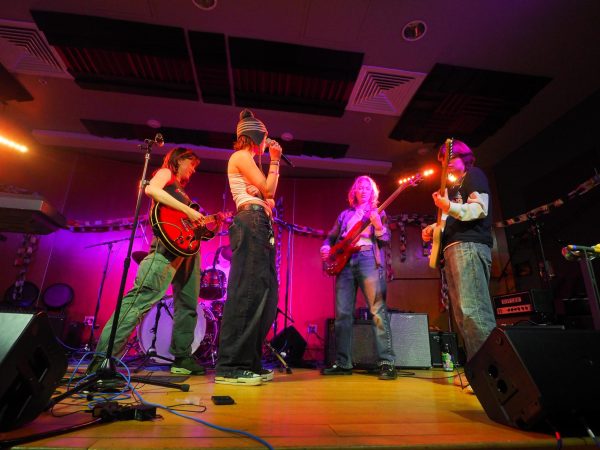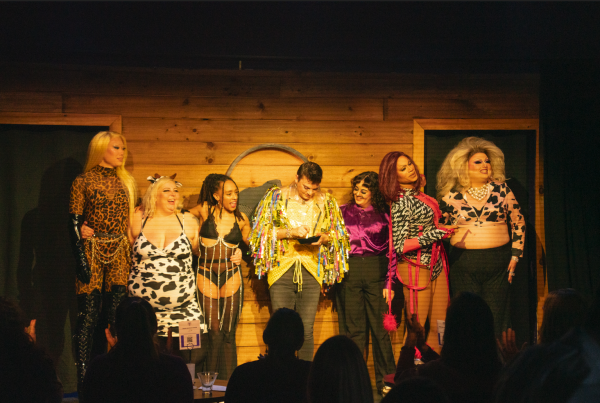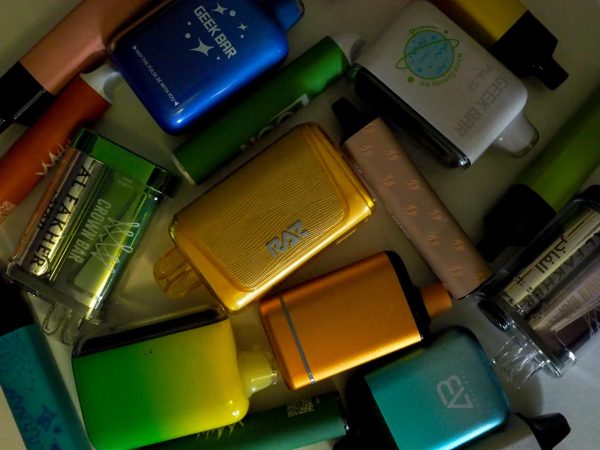Fleming welcomes new director and new focus on community-engaged practice
Sonja Lunde, the Fleming Museum of Art’s new director, in the museum’s Marble Court Jan. 19. Lunde previously worked at the Utah Museum of Fine Arts for 14 years.
On a gloomy winter day, wearing a bright yellow top contrasting the weather, Sonja Lunde, the Fleming Museum of Art’s new director, spoke about the future of the museum.
Departing from her 14-year tenure at the Utah Museum of Fine Arts and following the 20-year term of her predecessor as Fleming director, Lunde is ushering in a new chapter for the Fleming. Lunde started her work at UVM on Oct. 17, 2022.
For Lunde, who was born and raised in Vermont, the position is something of a homecoming, she said.
On top of it being in the state where she grew up, her connection to the Fleming is special for another reason—her grandfather’s work was once displayed there.
“He was included in an exhibition of amateur Vermont artists back in the ‘40s,” Lunde said. “He was a self-taught photographer and had a dark room in his basement in Barre, Vt.”
That exhibition created a connection between Lunde’s family and the Fleming that has been passed down through generations.
“I’ve always had a fondness for the Fleming,” she said. “It was always a nice story that we told in our family.”
Despite the artistic aptitude in her lineage, Lunde said she isn’t an artist herself.
“I’m not an art maker, at all,” she said. “I’m an art admirer.”
Lunde’s appreciation for art really developed during a year in the French Alps between high school and college, she said. It was during this year abroad that she traveled around to various museums and gained a deeper appreciation for all sorts of artistic media.
“I spent a lot of time visiting art museums in Europe, and when I did start my undergraduate it became pretty obvious for me that I needed to be in the art history department,” she said.
Her appreciation of art and work at the University of Utah’s Museum of Fine Arts, where she was most recently the deputy director of planning and programing, helped prepare her for her role as Fleming Director.
“Both are college art museums at a public university, so [there are] lots of similarities,” Lunde said. “That museum’s a little bit bigger than the Fleming, but [it has a] similar kind of collection—very, very broad in terms of scope and representation from artists and places around the world.”
Additionally, in a time where museums are reevaluating their structure, part of what drew Lunde to the role were the opportunities presented by working at the Fleming.
“There’s a real sea change kind of happening in the field right now that I think has been evolving for quite some time, but I think was really shifted into a next level gear at the onset of the pandemic, and certainly all the social and racial justice issues that were sparked especially in the summer of 2020,” Lunde said.
This change centers community-engaged practice and decentering the museum’s voice as one of authority, and creating culture with the staff, colleagues and larger community that promotes the sharing of ideas and a more collaborative leadership model, she said.
“A lot of work has been happening to really examine the Fleming’s missions and goals and really examine what stories we choose to tell, how we tell them and with whom we tell those stories,” Lunde said.
The community of learning and questioning at universities helps foster the changes that are happening in museums like the Fleming across the country, she said.
“It’s a place where critical dialogue is inspiring and it’s welcome and it’s expected,” Lunde said.
That conversation and the work being done at the Fleming that started under the Fleming’s previous director, Janie Cohen, were components of what attracted Lunde to the position—and she’s excited to be a part of it.
“College and university exams have an extra special, unique opportunity to shed a lot of the perceived and real, frankly, baggage that can come along with deeply rooted traditions that come with museums, and specifically art museums,” Lunde said.
This “baggage” Lunde is concerned with revolves around the colonialist history upon which museums across the world have been founded.
“This kind of work, there’s no sort of end point, there’s not a point where we say ‘OK, we’re done doing that now,’” Lunde said. “To be done well, it needs to be a lens through which we look at everything we do here.”
Some of the new values held by the Fleming are reflected in “The Fleming Reimagined,” which at its simplest form is a value statement that commits the museum to establishing itself as an inclusive, responsive space, Lunde said.
Through the value statement, shared authority, inclusivity, shared leadership, community engagement and student-focused work are all prioritized.
“It is just a different way, frankly, for museums to work. That has just not always been evident in the world of museum work,” Lunde said.
In this moment of transition for the Fleming, its new director is reflecting on how to bring these established values to the forefront, given the various resources of the museum.
“How do we move forward to implement these values?” Lunde said. “What does that look like in the space?”
Part of answering these questions includes bringing in more voices, and Lunde’s message to students is simple: stop by.
“I would invite every single student to at least stop by once, walk around, spend time,” Lunde said. “It’s a real lucky thing to be a student on a campus that has an art museum.”
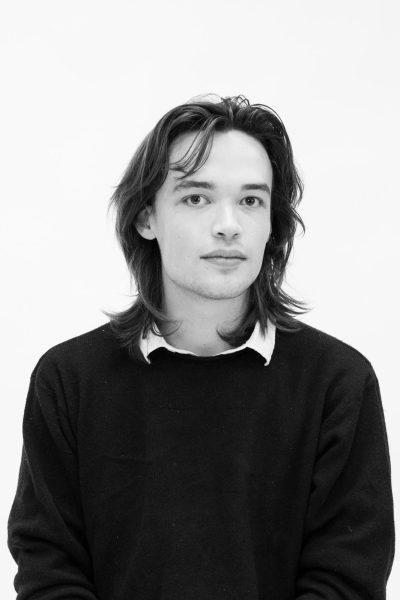
(He/him)
Eamon Dunn is a senior English major with a studio art minor. He joined the Cynic his sophomore year as a culture staff writer and was the...


